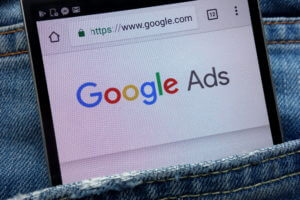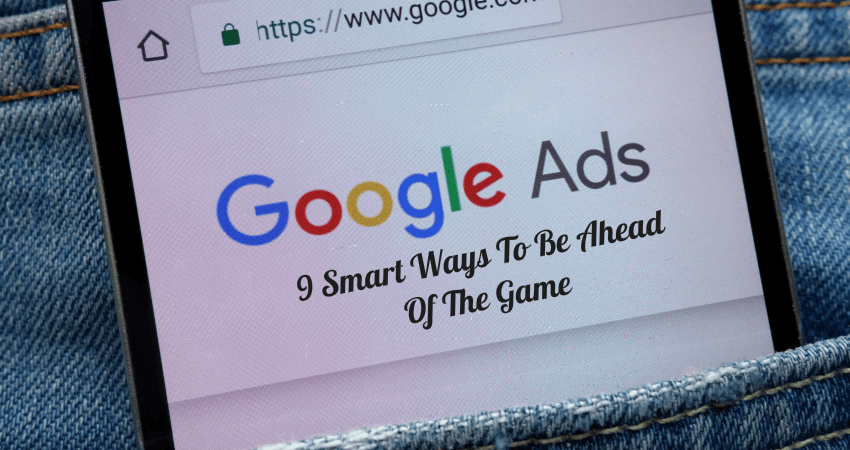What worked as Google Ads Expert Tips in early 2019 and 2020 will not work as well in 2021.
Shifts are happening faster than you can blink.
Here are nine expert tips to get ahead of the game for Google Ads success in the coming year.
Google Ads Expert Tips #1: Automate Your Bidding
The first Google Ads Expert Tip for 2021 come from Brady Cramm, Director of PPC at Directive Consulting
.
“To make sure your PPC effort succeeds, I recommend using automated bidding rules on Google Ads. It’s a sure way to save time and money.”
Automating your bidding by using the maximize clicks feature will increase site visits to get as many clicks as possible for your specified budget.
Brady Cramm Example
For example, in the rules section of your Google Ads dashboard, you can create automated rules for account optimization:
 Here you tell Google Ads how to manage events in your account, like increasing your ad spend when the average cost per click is low:
Here you tell Google Ads how to manage events in your account, like increasing your ad spend when the average cost per click is low:
To (try to) avoid any risk, Brady Cramm uses Shape.io to manage their budget and ad spend across so many concurrent campaigns.
With Shape, you can set up pre-defined targets with caps for multiple campaigns under each client.
And it offers a cool, all-in-one visualization of all channels.
It includes budget trend, predicted spend based on real-time performance, how increases or decreases will affect performance, and also an autopilot feature to catch trend lines to not overspend.
2. Use Google Ads and Facebook to Drive Content Success
When looking to use PPC to grow, most companies will hit the SERPs and target bottom of the funnel keywords, like “buy SEO tool.”
You know, keywords that signify someone wants to buy something. ASAP. But these don’t work and content engagement campaigns do, and for good reason:
These people have likely never heard of you. That’s why Brian Jackson, Chief Marketing Officer at Kinsta, gives this tip:
There’s a direct correlation between social proof and increased search traffic. It’s more than people think. Organic reach is just going to get worse and worse and worse. It’s never going to get better.
That’s why I’d suggest using Google Ads and Facebook together to automate content success.
Here we’re putting out content on social media like Facebook along with both a Google tag and Facebook pixel code on the same landing page so that you can re-market to your audience throughout the Google display network along with Facebook
According to Brian Jackson this is not just theory, it works, and he proved it.
Brian published a blog post for Kinsta on bootstrapping, which went live in November, and instantly it hit the top of Hacker News because of the increased traffic of using both Facebook & Google. This resulted in their website getting a consistent 400+ concurrent visitors all day.
Within hours their post was ranking on the first page for the term “bootstrapping,” which receives around 256,000 monthly searches.
 Try cross-promoting your content like Brian by utilizing Facebook to distribute and Google to re-market interested users.
Try cross-promoting your content like Brian by utilizing Facebook to distribute and Google to re-market interested users.
Kinsta’s big goal with content promotion is to build traffic and get as many eyeballs as possible. Content success is a key part of generating leads.
Google Ads Expert Tips #3: Put Your Message Match on Steroids
ShipBob is making a killing by optimizing message match across all campaigns They’ve been able to scale their ad spend over 60% quarter-over-quarter while keeping ROI the same.
How did they do it?
We hyper-focus on customization from ad to landing page to on-boarding experience, with a special attention on the ad-to-landing page experience.
We create dynamic header and copy changes throughout the page. Then we mirror our ad campaigns and ad groups to each landing page, as we run over 1,000 campaigns and over 100,000 groups.”
According to Casey Armstrong, “you’re treating landing pages like content mapping, aligning unique pages with each different offer, segment, or audience within each stage.”
Using SKAGs, they match each landing page to a specific, single keyword ad group: Better message match = better Quality/Relevance Scores = lower Cost Per Leads.
But if you want better results, you need to put your message match on steroids.
Align messaging for each page to:
- Who is visiting,
- Why they’re visiting, or
- Where they’re visiting from.
And that’s where Dynamic Text Replacement comes into play,
A handy little off-the-shelf feature in the Unbounce editor to help you personalize PPC landing page content.
Inside the editor, highlight a content section, like the headline, to have DTR. Click on the “Properties” section, then select “Dynamic Text Replacement.
Next, set the parameter and default text to show visitors as a backup plan.
AdWords IF functions are a game changer for message match, now you can pair the two to customize ad + page, automatically.
For example, use RLSA (Retargeting List Sales ADs) audiences or device type to customize ad text on the fly, changing the offer for each.
Take advice from Samantha Drane of CPC Strategy
:
 The way we use our mobile device differs from the way we search on the desktop. Mobile is more at the moment’-maybe you’re going somewhere or looking for something near you, but they consider desktop more of a research tool.
The way we use our mobile device differs from the way we search on the desktop. Mobile is more at the moment’-maybe you’re going somewhere or looking for something near you, but they consider desktop more of a research tool.
The challenging part is doing this for major campaigns and scaling your efforts. Dynamic text replacement solves this (almost) overnight!
And this is just the beginning.
Create page templates for each segment, too. Besides copy, other page elements customize, (like an attorney-looking man that pops up when you search for “attorneys”:)
(Note: example’s a male because the targeting was primarily male-specific.)
Laser-targeting each landing page to every single keyword you’re bidding on might be the lowest-of-low-hanging-PPC fruit.
Obsessive messages decreased cost per converted click from $482.41 to $147.65, while increasing the conversion rate from 4.08% to 12.76%.
Multiply those cost changes against a $30,000/month budget (which this was), and you’re talking about hundreds of more leads for tens of thousands less.
Google Ads Expert Tips #4: Upgrade Offers, not Buttons
Google Ads can trick you.
Nowhere else gets sales-ready leads with such precision and accuracy. No other platform – online or off – delivers people to your door with wallet in hand.
Why?
Keywords and intent!
That’s why the same old boring “Free Quote” landing page works OK on Google Ads, but bombs on every other channel out
Separating double-digit landing pages from sub 1-2% is the offer you’re using to draw people near. Three billion in ad spend analyzed can’t be wrong.
So no direct hard sale…
Just one that focuses on the end results your customers and clients receive…
Except, how do you balance message match (who they are, where they’re coming from, etc.),with a more persuasive copy that gets them to convert?
Joanna Wiebe from Copy Hackers has the trick to balancing the two (and a few more tips):
If you want to boost your results in 2021, try the 10/90 messaging hierarchy layout.
First, focus on optimizing the consumer offer.
 Then communicate that value with better copy. And remember: Optimize your offers and persuasion, not your buttons!
Then communicate that value with better copy. And remember: Optimize your offers and persuasion, not your buttons!
But what is the 10/90 messaging hierarchy layout? Customize the top ten percent for message match factors like:
Intent and funnel stage
Messaging they are expecting to receive in that given stage And the bottom 90 percent for persuasion, like:
- Why they should care?
- What is in it for them?
- What they will receive in end-benefits after?
Then, you can split test different offers on your pages for the same campaign. If it’s a quote request, free assessment, webinar, or interactive calculator, like the one they created for Podia:
Simple changes in your button text won’t do much if it’s not paired with an upgraded offer that results in more value.
Google Ads Expert Tips #5: Split testing – not AB testing
The experts at Wistia recommend this.
Put your video to the test by making two different versions of the page and seeing which one drives more conversions, the one with or without the video.
Then you can even split test different videos or demos”. Split testing pages, not necessarily A/B testing, is a recurring theme.
Brady Cramm from Directive Consulting also loves to split test, especially video content. They’ll do on-demand or evergreen (as opposed to scheduled ones), so prospects can view the video at their own convenience.
Here’s an example:
Extras like this help a lot in a competitive environment,
Like Google Ads or Capterra, where the same person may click on the first ten companies to compare them all within a few minutes.
Convenience can provide a big lift.
Brady Cramm focuses on ad copy next, but not just for message match in this case.
Page elements, like teaser bullets, provide quick summaries for the main outcomes and benefits (not features) a prospect might get.
 This is a common mistake Brady sees on most B2B landing pages. There’s a poison in many B2B companies, where everyone uses their own language around the office. They all understand it.
This is a common mistake Brady sees on most B2B landing pages. There’s a poison in many B2B companies, where everyone uses their own language around the office. They all understand it.
But nobody (outside of the company) knows what they’re saying when they bring it to the web.”
6. Device Targeting: Can Make or Break Success in 2021!
Device targeting can make or break your campaign’s offer messaging. Landing pages need different treatment if they’re on mobile vs. desktop.
One time, a Directive Consulting client had their form below the fold on mobile devices.
The page was responsive, but the mobile layout wasn’t ideal; forcing the form out of sight, out of mind. We swapped [the form] to the top and conversions went through the roof.
Mobile traffic was sharing and clicking, which is good. But they weren’t staying very long, consuming it, or opting-in. So we also segmented paid campaigns only for mobile or desktop.”
Pay attention here: mobile OR desktop, NOT both. Users exhibit unconventional behavior on mobile vs. desktop.
Brand awareness campaigns or content promotion might work well on social for those reasons. However, lead gen campaigns are often better reserved for desktop.
I’ve confirmed this across several promoted content tests on Facebook.
One company, Getcodeless, spent $984.69 on one content campaign and found that the three primarily mobile placements (Audience Network, Messenger, and Instagram) significantly outperformed desktop and right column placements for top-of-the-funnel traffic.

It makes no sense to continue spending on desktop placements. You might as well drive cheap clicks, so you can later re-target them with better offers on desktop when there’s a better chance they’ll convert.
Here’s how the math breaks down if you shifted more ad budget to the mobile-based placements. Nearly 2,000% more clicks for the same spend.
And we could repeat this trend again and again and again.
So the campaign success wasn’t indicative of a single headline or button or other variable on your PPC landing pages.
But from aligning everything from the funnel segmentation, with message match, and offer messaging for each aspect or placement.
Brad Smith, founder at Codeless Interactive (a content creation company for the best SaaS sites) is:
Mobile campaigns are great when running ads for top-of-the-funnel activities. Desktop succeeds when you want to convert bottom-of-the-funnel leads.
So, tailor your ad targeting to each strength”.
7. Stop Pushing Sales and Start Pushing Value
Yes, you read that right. Being too pushy for sales with PPC in 2021 is a big mistake.
Google has shifted to be customer-centric and advertisers should join. Google Ads have intent, but people aren’t converting on a dime.
Louis Grenier, Content Lead at Hotjar, says:
“2021 for us means going back to the fundamentals. We’ve identified opportunities for topics we are not bidding for yet purely because they are not the features we offer.”
Instead of trying to convert visitors searching for such topics, we will build funnels to share our point-of-view and convert the right leads so they stick around longer.”
This means producing content that people want to read and advertising it on Google results. Building up traffic and nurturing them from brand awareness to sale, rather than pushing high-intent keywords to get a 2% conversion rate.
Next time you run ads, target keywords where advertisers aren’t giving value and watch your conversions and CTR go through the roof!
 Instead of promoting your product as the best, promote your brand as a value proposition.
Instead of promoting your product as the best, promote your brand as a value proposition.
The advertiser provides direct value by comparing CRMs and giving content, rather than pushing their product first.
What else can you do? Almost unlimited tactics come to mind.
One, for example, is directing remarketing traffic via Google Ads to a knowledge base software where existing customers or free trial users can improve their usage of your tool, thus becoming dependent on it for success:
This works to strengthen the value your tool brings to the table.
The better you can get someone to use your product or service, the better growth they will get, and the more they will spend with your business.
Focus on value in 2021, not selling. Value will take care of the selling for you.
8. Test Different Bidding Models Like Affiliate Marketing
Affiliate marketing is an interesting topic that can give us insight into PPC success. With affiliate marketing, there are a few common types of payment structures for affiliate marketers:
- Pay per sale
- Pay per lead
- Pay per click
Adam Enfroy, affiliate Partnerships Manager at BigCommerce, recommends:
“Just like Google Ads and PPC, there are many models of bidding that can work (or fail).”
My tip to drive success in 2021 is that of testing your bidding models just like you’d do in affiliate marketing: CPC vs. CPL or CPA.”
With Google Ads bidding, you can choose from any of the following types:
- Target CPA (Cost Per Acquisition)
- Target ROAS (Return On Ad Spend)
- Maximize Conversions
- Enhanced Cost Per Click (ECPC)
- Maximize Clicks
- Manual CPC Bidding
- Target Search Page Location
- Target Outranking Share
- CPM Bidding (Cost Per Thousand Impressions)
- VCPM Bidding (Cost Per Viewable Thousand Impressions)
You can find every detail on how and when to use each of them in the Ultimate Guide to Google Ads Bidding Strategies.
9. Run an Account-Based Marketing Plan
David Zheng of WiseMerchant and GrowthWit works all day looking for easy opportunities with PPC campaigns.
He’s constantly on the lookout for ways to:
“Double-down with resources to get the most growth. Then once we can get it to work a bit, we increase conversion rates. Get strangers to give us an email, convert to a free deal, and then close into a new account.”
For example:
If one Google Ads campaign is already working, can you 10x it? Or does it make more sense to test paid social ads with remarketing on Google’s display network for content amplification?
In 2021, I recommend experimenting with account-based marketing (ABM) techniques. You can land high-profile clients rather than chasing 1,000 small clients on PPC.
Less is more should be your mantra this year.”
Let’s make it real with an example.
David and his team can identify and research quality leads without ever leaving LinkedIn’s Sales Navigator to start:
Then they can run ads for different offers, including eBooks to webinars or consultations, to see what sticks. From there, they can re-market them on the display network and drive an opt-in to email them.
 David uses tools such as ClearBit and Gmass. In addition, they use Canva to create a lot of the sales and marketing collaterals, like presentations and PDFs, to help them get a foot in the door.
David uses tools such as ClearBit and Gmass. In addition, they use Canva to create a lot of the sales and marketing collaterals, like presentations and PDFs, to help them get a foot in the door.
You go make your own sales collateral with this Canva template. These bigger, complex deals don’t happen overnight, though.
Data from Salesforce shows that the average deal takes at least 6-8 touches’ before closing. Re-engaging loose leads throughout the process is critical.
Almost every single study shows that remarketing is one of the most efficient ways to close more customers.
By using RLSAs (Remarketing Lists For Sales Ads), you can produce ads for smaller audiences and make them more targeted and focused, tapping into account-based marketing tactics.
In 2021, personalization is going to win. But not just any personalization: real personalization based on real interests and behavior with your business.
Google Ads Expert Tips Conclusion:
Google Ads is constantly updating, changing, and improving. And so is consumer behavior. Take a hard look at your current Google advertising strategy.
Have you updated campaigns?
Is your bidding automated?
Are you using upgrade offers, personalization, and premium message match tactics?
If not, it’s time to get ahead of the game.
If you enjoyed this, you may also like our article “How To Build A Lead Sucking Online Sales Funnel”
And if you want to build a profitable online business join our newsletter and we’ll send you our “5 steps to Facebook Freedom” video training series along with the 7 figure online business blueprint masterclass free – check it out here
Make it happen,
Liam


